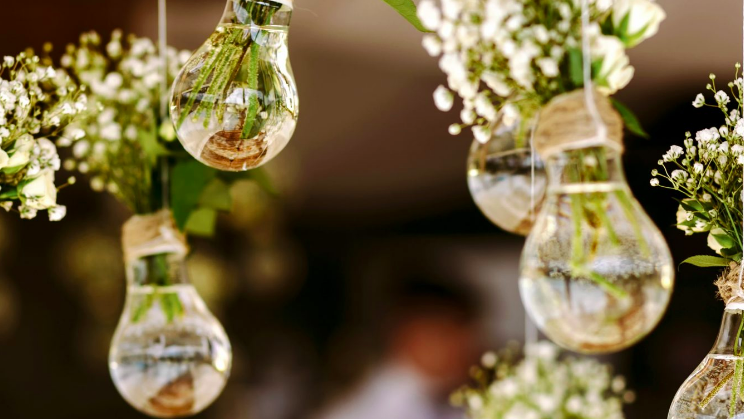Sponsored Post – from Texas Disposal Systems
Wedding receptions are exciting, romantic and… wasteful? Even the most environmentally-conscious couple might find themselves stumped when it comes to planning a sustainable celebration.
Weddings are notoriously wasteful, with the average nuptial producing 400 to 600 lbs of waste on average. In the U.S. alone, with roughly 2 million weddings every year, that creates 800 million to 1.2 billion pounds of waste from weddings annually.
Going green for a wedding requires a set amount of balance. Practical things a couple needs to provide their guests (i.e. food/snacks, napkins) have to work with the expected details of a modern wedding (i.e. flowers, decor, party favors) – not to mention that everything needs to fall into budget.
There’s a ton of information on the Internet about how to make eco-friendly choices for your wedding. So, rather than just provide a list of small details that will make for a slightly more sustainable wedding, we’d like to provide you with a few ways to consider all of the details for your big day.
By shifting your approach to decision making for your event, you’ll find there are actually tons of opportunities to substantially cut down the waste produced at your wedding.
3 Simple Ways to Shift Your Approach & Plan an Environmentally-Friendly Wedding
1. Work with sustainable vendors whose values align with your own
Only work with vendors who prioritize sustainable practices. Not only will these vendors have tons of creative and practical solutions for reducing waste, but you’ll also find that partnering with like-minded companies often makes it easier to meet the vision you have for your wedding.
With every vendor, there will be many opportunities to make more sustainable choices. When choosing a venue, for example, consider locations that are beautiful and interesting on their own, whether it’s from nature or designed architecture. The more beautiful a venue already is, the less you have to provide (or pay for!) decorations that typically get tossed after the fact.
Many venues that take sustainability seriously will have integrated that into every aspect of their facility, from lighting to AC. Directories such as the LEED Project Database can put you in the right direction of which buildings takes on these initiatives.
Beyond a venue vendor, there’s also been a surge of catering companies that have made concerted efforts towards reducing waste, such as composting food scraps and recycling. Other similar vendors, such as decorators or florists, may take approaches such as composting flowers after use or using recyclable materials for decor usage.
More than likely, your vendors will know more about making “green” choices in their respective fields than you do, so make sure to only hire companies who you feel confident are acting responsibly. Not only is it one less thing for you to worry about, but it just feels good to work with companies who champion the same causes you do.
2. Consider what can be upcycled or reused for your wedding
One of the largest deterrents of a sustainable wedding is all of the items that are used only once. This is especially true for decorations and table settings. Instead of purchasing all your items new, visit local thrift stores, vintage shops, or even your own cupboards for creative ways to decorate your venue. Here are a few ideas:
- Upcycle glass bottles for an eclectic assortment of vases.
- Ask your vendor if an event prior to yours would be willing to donate any decorations, table numbers, or flowers.
- Shop vintage for your wedding dress.
- Paint an old mirror with chalkboard paint and write table assignments on it rather than paper cards.
- Use vintage frames to display pictures of your family and engagement photos.
- Decorate with potted plants that can be replanted after the wedding rather than tossed.
3. Recycle, donate, or sell as much as possible
No matter how environmentally conscious you are, a large event like a wedding reception is going to have things left over from your big day. Aside from the food and paper waste, which will be disposed of properly (by choosing the right vendors), decorations, flowers, and other miscellaneous items will be left over to consider. Here are a few ways to make the most of what’s leftover from your wedding:
- If you have a friend or family member getting married shortly after you, they’ll likely appreciate your leftover candles, table numbers, vases, tablecloths, etc.
- For cut flowers, consider donating them to either a hospital, another event, or a cemetery. Most houses of worship will be willing to use cut flowers as decor for their worship services as well.
- Encourage your wedding party to sell their day-of wardrobe if they don’t think they’ll wear them again after the wedding. Better yet, look into rental options for your wedding party!
Feeling Good About The Impact of Your Wedding
Regardless of the style, size, or budget for your wedding, there are many small steps you can take to significantly reduce the amount of waste produced at your reception. By shifting how you think about the vendors you work with or where you source decorations, you’ll ultimately end up with a wedding that is much more representative of who you are as individuals and as a couple.
Please note – editorials and sponsored posts are written by guest writers to inform and educate the community on a variety of different viewpoints, as well as to share information about local eco-friendly businesses and organizations. However, they do not necessarily reflect the opinions of the Austin EcoNetwork.



